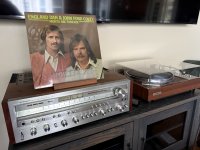Probably around the time of going into the 80's I remember the big thing, buzz word, if you will was discrete circuitry. It was better than IC's, integrated circuits, in audio gear. Receivers at the time like Harman Kardon at the time cost a premium because they were discrete opposed to the many competitors who used IC's.
It seems now with the push to Class D we are being told IC's, chips, are good. Or at least on par with those built with discrete circuitry.
I wondered about this and watched a tutorial of sorts on Class D. Probably just enough to be dangerous, LOL The guy literally made a Class D amp on a circuit board with a chip, power supply and the appropriate caps to do the low and high filtering. Some of these Class D amps today have some hefty price tags.
I bring this up with a genuine curiosity if chips are better now than those used back when in amps or is it apples and oranges? If IC's were not as good as discrete circuits then wouldn't the same still hold true today? Could the circuit being a chip be a handicap to Class D ever really being able to compete with a equal A/B amp?
I realize the IC's used back when were not used for Class D.
The cheaper class D amps tend to use ICs that encompass most of the class D circuit.
The better class D amps tend to use individual parts to compose the circuit. Some of those parts are chips but have a more general use, for example in any class D there is a comparator circuit. That circuit compares the incoming audio signal to the switching frequency and so produces an on or off state at its output. There are good comparators chips (that have a lot in common with opamps) and there are some excellent ones. This allows the designer more flexibility in designing the class D circuit. In a chip-based class D there is no such flexibility; you're stuck with whatever performance or lack thereof is built into the chip.
WRT your question about older amps corrosion is a factor that can kill older semiconductors. Seems to me newer parts are sealed better.
In the case of opamps, newer opamps perform quite a lot better than older ones. Anyone repairing older guitar effects pedals knows how important it is to use the right parts because the newer opamps often change the 'sound' of the pedal.
It is very difficult to build an opamp from discrete parts that has the kind of performance modern opamps have today!
With any amp that uses a chip for 90% of its circuit, availability down the road is often a concern. If the chip goes out of production it could be a real problem finding one that can be used to effect a repair. This is less likely to happen with class D circuits where smaller ICs are put together to create the whole.
I can tell you this: my receivers from the 1970’s (Pioneer SX1250 and Marantz 2270) use discrete components of individual transistors. The older receivers also used larger components that you could easily see. Modern receivers use integrated circuits and very small parts they call surface mount components. Also there could be differences in the amount of negative feedback used.
I will tell you that my older receivers still sound amazing and I wouldn’t want to put up against a similar priced receiver today. It would get smoked in all areas I bet.
Any electronics from the 1970s and 1980s have suspect electrolytic capacitors inside. They really should be replaced if you intend to keep using the amp or receiver.
Amps and receivers like the ones of your post tend to have electrolytics in the signal path so there can be quite a lot of them in there! If they are not sorted out you really are not hearing the unit at its best.
Oddly it was during this period that some of the best linear semiconductors were produced for consumer gear in particular. These days semiconductor producers would really rather make parts for switching applications; linear semiconductors are getting harder to find.
I just repaired a CM Labs solid state amp yesterday that made 100 Watts/channel. It was a brute in its day (I'm thinking late 1960s). But in terms of sound or performance there are older tube amps that were wider bandwidth and lower distortion. That amp combined both germanium and silicon transistors direct coupled together (creepy, but actually pretty reliable although there's no thermal feedback so thermal runaway is an issue), although the output was capacitively coupled. There's a lot to be said about how amplifier topologies have improved over the decades!

